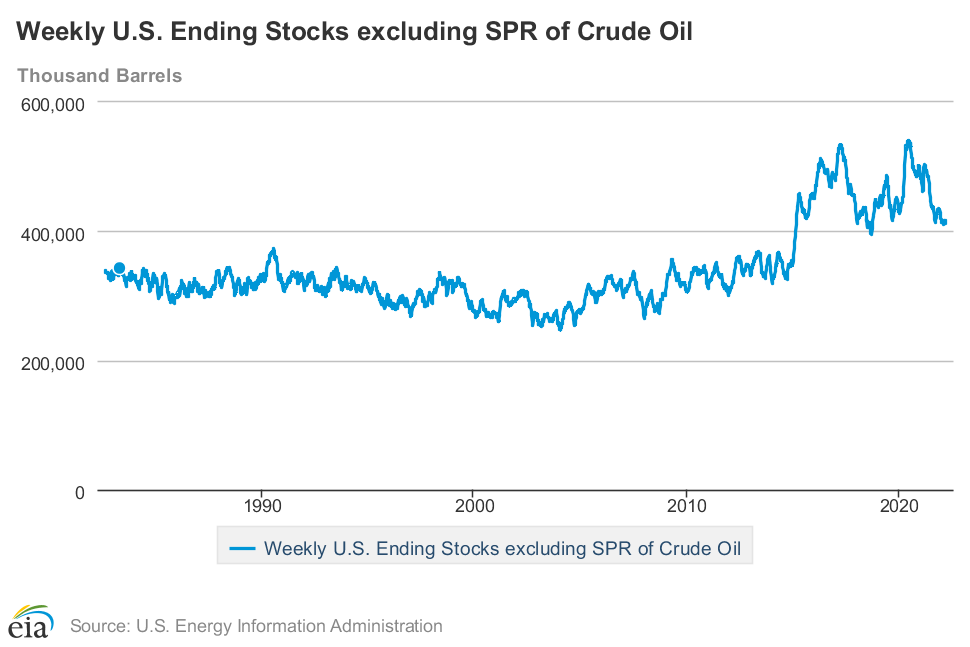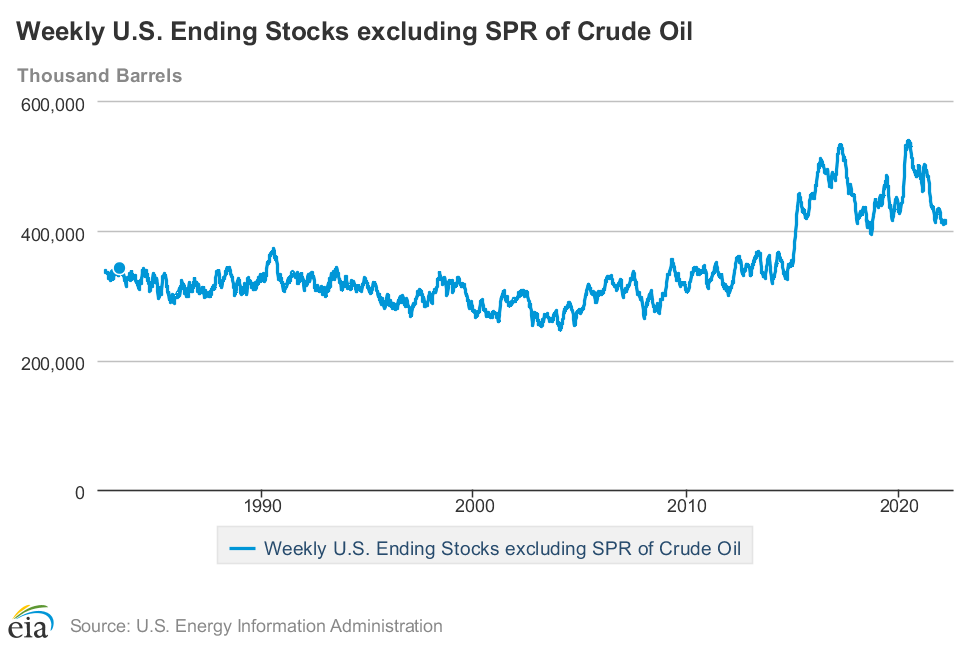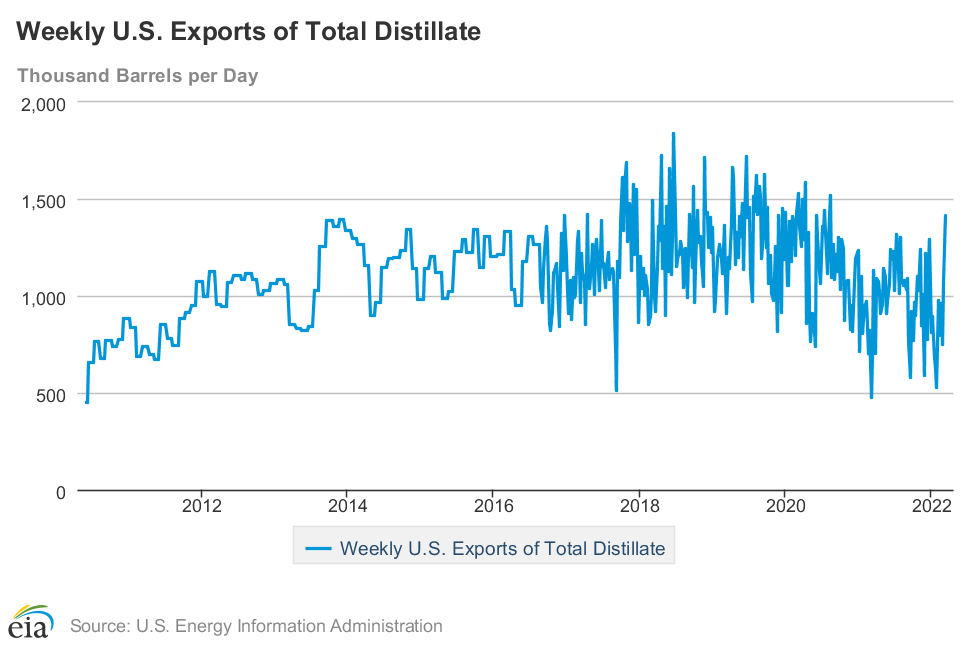Mixed Bag; Crude Oil, SPR, Oil and Product Supply, Distillates, etc.
RJS, Focus on Fracking,
Commercial crude supply rise as SPR falls to 19½ year low, total oil + products supply at new 95 month low; exports of distillates at a 20-month high after largest drop in domestic demand in 18 months
The Latest US Oil Supply and Disposition Data from the EIA

US oil data from the US Energy Information Administration for the week ending March 11th indicated that even after a big increase in our oil exports, we still had surplus oil to add to our stored commercial crude supplies for the fifth time in 16 weeks and for the 15th time in the past forty-two weeks, because of a big increase in oil supplies that could not be accounted for . . . our imports of crude oil rose by an average of 76,000 barrels per day to an average of 6,395,000 barrels per day, after rising by an average of 552,000 barrels per day during the prior week, while our exports of crude oil rose by an average of 514,000 barrels per day to an average of 2,936,000 barrels per day during the week, which together meant that our effective trade in oil worked out to a net import average of 3,459,000 barrels of per day during the week ending March 11th, 438,000 fewer barrels per day than the net of our imports minus our exports during the prior week . . . over the same period, production of crude oil from US wells was reportedly unchanged at 11,600,000 barrels per day, and hence our daily supply of oil from the net of our international trade in oil and from domestic well production appears to have totaled an average of 15,038,000 barrels per day during the cited reporting week…
Meanwhile, US oil refineries reported they were processing an average of 15,601,000 barrels of crude per day during the week ending March 11th, an average of 224,000 more barrels per day than the amount of oil than our refineries processed during the prior week, while over the same period the EIA’s surveys indicated that a net of 337,000 barrels of oil per day were being added to the supplies of oil stored in the US . . . based on that reported & estimated data, this week’s crude oil figures from the EIA appear to indicate that our total working supply of oil from net imports and from oilfield production was 880,000 barrels per day less than what was added to storage plus our oil refineries reported they used during the week…to account for that disparity between the apparent supply of oil and the apparent disposition of it, the EIA just inserted a (+880,000) barrel per day figure onto line 13 of the weekly U.S. Petroleum Balance Sheet in order to make the reported data for the daily supply of oil and for the consumption of it balance out, essentially a balance sheet fudge factor that they label in their footnotes as “unaccounted for crude oil”, thus suggesting there must have been an error or omission of that magnitude in this week’s oil supply & demand figures that we have just transcribed . . . moreover, since last week’s EIA fudge factor was at (-746,000) barrels per day, that means there was a 1,626,000 barrel per day difference between this week’s balance sheet error and the EIA’s crude oil balance sheet error from a week ago, and hence the week over week supply and demand changes indicated by this week’s report are completely worthless . . . however, since most everyone treats these weekly EIA reports as gospel and since these figures often drive oil pricing, and hence decisions to drill or complete oil wells, we’ll continue to report this data just as it’s published, and just as it’s watched & believed to be reasonably accurate by most everyone in the industry…(for more on how this weekly oil data is gathered, and the possible reasons for “unaccounted for” oil, see this EIA explainer)….
This week’s 337,000 barrel per day net increase in our overall crude oil inventories came as 621,000 barrels per day were being added to our commercially available stocks of crude oil, while 283,000 barrels per day of oil were being pulled out of our Strategic Petroleum Reserve, still part of the Biden administration’s original plan to release 50 million barrels from the SPR to incentivize US gasoline consumption . . . including other withdrawals from the Strategic Petroleum Reserve under similar recent programs, a total of 80,636,000 barrels have now been removed from the Strategic Petroleum Reserve over the past 20 months, and as a result the 575,513,000 barrels of oil remaining in our Strategic Petroleum Reserve is now the lowest since June 28th, 2002, or at a new 19 1/2 year low, as repeated tapping of our emergency supplies for non-emergencies has already drained those supplies considerably over the past dozen years . . . with Biden’s recent announcement that a further 30,000,000 million barrels will be pulled out of the SPR in the wake of the Ukraine situation, the US will have roughly 28 1/2 days of oil supply left in the Strategic Petroleum Reserve when the current SPR withdrawal programs are complete.
Further details from the weekly Petroleum Status Report (pdf) indicate that the 4 week average of our oil imports rose to an average of 6,327,000 barrels per day last week, which was 15.7% more than the 5,4871,000 barrel per day average that we were importing over the same four-week period last year . . . this week’s crude oil production was reported to be unchanged at 11,600,000 barrels per day as the EIA’s rounded estimate of the output from wells in the lower 48 states was unchanged at 11,200,000 barrels per day, while Alaska’s oil production was unchanged at 441,000 barrels per day . . . US crude oil production had reached a pre-pandemic high of 13,100,000 barrels per day during the week ending March 13th 2020, so this week’s reported oil production figure was 11.5% below that of our pre-pandemic production peak, but 37.6% above the interim low of 8,428,000 barrels per day that US oil production had fallen to during the last week of June of 2016…
US oil refineries were operating at 90.4% of their capacity while using those 15,601,000 barrels of crude per day during the week ending March 11th, up from a utilization rate of 89.3% the prior week, and in line with the historical utilization rate for early March refinery operations, when the need for seasonal maintenance typically causes rotating shutdowns . . . the 15,601,000 barrels per day of oil that were refined this week were 16.1% more barrels than the 13,433,000 barrels of crude that were being processed daily in the wake of winter storm Uri during week ending March 12th of 2021, but 1.4% less than the 15,820,000 barrels of crude that were being processed daily during the week ending March 13th, 2020, when US refineries were operating at what was then a lower than normal 86.4% of capacity at the onset of the pandemic…
Even while the amount of oil being refined this week was higher than a week earlier, gasoline output from our refineries was somewhat lower, decreasing by 197,000 barrels per day to 9,380,000 barrels per day during the week ending March 11th, after our gasoline output had increased by 303,000 barrels per day over the prior week . . . this week’s gasoline production was still 5.6% more than the 8,877,000 barrels of gasoline that were being produced daily over the same week of last year, but 6.0% less than the gasoline production of 9,974,000 barrels per day during the week ending March 13th, 2020 . . . on the other hand, our refineries’ production of distillate fuels (diesel fuel and heat oil) increased by 305,000 barrels per day to 4,945,000 barrels per day, after our distillates output had decreased by 73,000 barrels per day over the prior week…with this week’s increase, our distillates output was 17.0% more than the 4,228,000 barrels of distillates that were being produced daily during the storm impacted week ending March 12th of 2021, and 5.5% more than the 4,686,000 barrels of distillates that were being produced daily during the week ending March 13th, 2020…
With the decrease in our gasoline production, our supplies of gasoline in storage at the end of the week fell for the sixth consecutive week, decreasing by 3,615,000 barrels to 240,991,000 barrels during the week ending March 11th,after our gasoline inventories had decreased by 1,405,000 barrels over the prior week . . . our gasoline supplies decreased by more this week than last even as the amount of gasoline supplied to US users decreased by 18,000 barrels per day to 8,944,000 barrels per day, because our imports of gasoline fell by 229,000 barrels per day to 531,000 barrels per day, and because our exports of gasoline rose by 113,000 barrels per day to 780,000 barrels per day . . . but even after 6 straight inventory drawdowns, our gasoline supplies were still 5.6% higher than last March 12th’s gasoline inventories of 232,075,000 barrels, when shortages in the wake of Winter Storm Uri had caused back to back record draws after, and still close to the five year average of our gasoline supplies for this time of the year . . .
This week’s big increase in our distillates production and our supplies of distillate fuels increased for the first time in nine weeks and for the eighth time in twenty-eight weeks, rising by 332,000 barrels to 114,206,000 barrels during the week ending March 11th, after our distillates supplies had decreased by 5,230,000 barrels to a seven and a half year low during the prior week . . . our distillates supplies managed to increase this week because the amount of distillates supplied to US markets, an indicator of our domestic demand, fell by 883,000 barrels per day to 3,704,000 barrels per day, even as our exports of distillates rose by 341,000 barrels per day to a 20 month high of 1,074,000 barrels per day, while our imports of distillates fell by 52,000 barrels per day to 222,000 barrels per day . . . but after thirty-four inventory decreases over the past forty-nine weeks, our distillate supplies at the end of the week were still 17.1% below the 137,747,000 barrels of distillates that we had in storage on March 12th of 2021, and about 16% below the five year average of distillates inventories for this time of the year…

Meanwhile, despite the jump in our oil exports, our commercial supplies of crude oil in storage rose for the 12th time in 32 weeks and for the 17th time in the past year, increasing by 4,345,000 barrels over the week, from 411,562,000 barrels on March 4th to 415,907,000 barrels on March 11th, after our commercial crude supplies had decreased by 1,863,000 barrels over the prior week . . . with this week’s increase, our commercial crude oil inventories were still about 12% below the most recent five-year average of crude oil supplies for this time of year, but were still around 26% above the average of our crude oil stocks as of the second weekend of March over the 5 years at the beginning of the past decade, with the disparity between those comparisons arising because it wasn’t until early 2015 that our oil inventories first topped 400 million barrels….since our crude oil inventories had jumped to record highs during the Covid lockdowns of spring 2020 and remained elevated for more than a year after that, our commercial crude oil supplies as of this March 11th were still 17.0% less than the 500,799,000 barrels of oil we had in commercial storage on March 12th of 2021, and were also 8.3% less than the 453,737,000 barrels of oil that we had in storage on March 13th of 2020, and also 5.4% less than the 439,483,000 barrels of oil we had in commercial storage on March 15th of 2019…
Finally, with our inventory of crude oil and our supplies of all products made from oil remaining near multi year lows, we are continuing to keep track of the total of all U.S. Stocks of Crude Oil and Petroleum Products, including those in the SPR . . . the EIA’s data shows that the total of our oil and oil product inventories, including those in the Strategic Petroleum Reserve and those held by the oil industry, and thus including everything from gasoline and jet fuel to propane/propylene and residual fuel oil, fell by 5,567,000 barrels this week, 1,724,594,000 barrels on March 4th to 1,719,027,000 barrels on March 11th, after our total supply had decreased by 10,619,000 barrels over the prior week, and are now down by 69,406,000 barrels this year…that left our total supplies of oil & its products now at the lowest since April 4th, 2014, or at a new 95 month low, even after this week’s sizable increase in commercial crude inventories.


Etc. …
With Inflation Surging, Biden Targets Ocean Shipping
NY Times – March 21